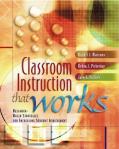While collaboration applies specifically to this week’s tag in Issues and Advances in Education Technology, it can certainly be applied to nearly every aspect of effective teaching. In order for teachers to be outstanding at their craft, they must learn to work with other teachers through collaborative project. This learning process mirrors the learning that students go through in the classroom. As the Washington State Educational Technology learning standard (EALR 1) states very clearly, “Students use technology within all content areas to collaborate, communicate, generate innovative ideas, investigate and solve problems” (Standards). Yet technology doesn’t drive collaboration; it simply acts as a tool to reach that level of learning. As Robert Marzano states in Classroom Instruction that Works, the pedagogical reasoning behind collaboration exists in grouping and cooperative learning as a strategy to reach student achievement.
Marzano points to researchers David Johnson and Roger Johnson, who in 1999 identified five characteristics of cooperative learning. Marzano writes:
- Positive interdependence (a sense of sink or swim together)
- Face-to-face promotive interaction (helping each other learn, applauding success and efforts)
- Individual and group accountability (each of us has to contribute to the group achieving its goals)
- Interpersonal and small group skills (communication, trust, leadership, decision making, and conflict resolution)
- Group processing (reflecting on how well the team is functioning and how to function even better) (Marzano 85-86).
With these characteristics in mind and the hard empirical data to back them up, Marzano makes the case for cooperative learning or collaboration. As the world and thus classrooms (and students) become more immersed in technology, it only makes sense to apply this same pedagogical reasoning to the use of new technology. Thus Washington State created new Educational Technology specific standards and schools look to find ways to utilize these collaborative tools like blogs, wikis, discussion boards, and chats. Yet as ISTE’s Wikispaces point out, which technology to use depends on the purpose of one’s collaboration. Additionally, Miguel Guhlin shows educators when to use blogs, wikis, and Google docs with the same reflection in mind. Choosing which 2.0 technology to use moves an attempt of fulfilling a standard to an inspired classroom with incredible learning opportunities.
technology, it only makes sense to apply this same pedagogical reasoning to the use of new technology. Thus Washington State created new Educational Technology specific standards and schools look to find ways to utilize these collaborative tools like blogs, wikis, discussion boards, and chats. Yet as ISTE’s Wikispaces point out, which technology to use depends on the purpose of one’s collaboration. Additionally, Miguel Guhlin shows educators when to use blogs, wikis, and Google docs with the same reflection in mind. Choosing which 2.0 technology to use moves an attempt of fulfilling a standard to an inspired classroom with incredible learning opportunities.
I underwent this type of reflection this week as I discussed the use of Moodle in my junior history class. I spoke with administrators and our technology department head about this as a possibility and they are excited. I plan to start this in the coming weeks, but not just to do it because it is available! Bradford Davey writes on ISTE’s Wikispaces a description of my scenario almost perfectly. He describes a great collaborative project utilizing 2.0 technology, but writes more about the skills gained outside of that realm. He states, “Although digital videography is a great technology skill, it is not the focus of this story….Their critical thinking skills came from problem solving for the other school involved in the project, working to solve the logistics of time zones, and thinking differently about their ability to communicate to a much larger global community. The project truly changed their perspective” (Davey). I want to have an experience in my classroom like Davey’s. While I use pairs and group opportunities on an almost daily basis in my classroom, there are still students who do not participate as much as I would like them to. Additionally, some students process information in a different way and may not be ready to raise their hand in class. Lastly, some students may feel intimidated to participate, despite any welcoming activities I may involve them in, due to race, gender, socio-economic status, or a variety of other factors.
The use of Moodle can alleviate these concerns and engage students in collaboration they haven’t experienced yet. It can reach EALR 1.1 which states, “Demonstrate creative thinking, construct knowledge and develop innovative products and processes using technology” (Standards). I am excited to begin the process and look forward to the results of this collaboration in my classroom.
Resources:
ISTE Wikispaces. (n.d.). Retrieved from the ISTE Wiki: http://nets-implementation.iste.wikispaces.net/Communication++and+Collaboration
Marzano, R.J., Pickering D.J., & Pollock, J.E. (2001). Classroom Instruction that Works. Alexandria, VA: Association for Supervision and Curriculum Development.
Office of Superintendent of Public Instruction. (2008). K-12 Educational Technology Learning Standards Retrieved from: http://www.k12.wa.us/edtech/pubdocs/K12EdTechStandards_12-08_MostRecent.pdf
